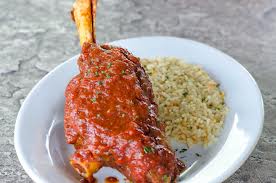 In Puerto Rican and Nuyorican cuisine, one of our aces is asopao. I think it’s a conjured up word from our culture. Spanish meas “soup.” An asopao is A-soup+; that is, a hearty, stick to the ribs stew that, though hailing from the Caribbean, is prefect for the kind of weather we are now enduring on the East Coast, or any Nordic climate. Nothing beats this hefty dish traditionally served with tostones (fried green plantains).
In Puerto Rican and Nuyorican cuisine, one of our aces is asopao. I think it’s a conjured up word from our culture. Spanish meas “soup.” An asopao is A-soup+; that is, a hearty, stick to the ribs stew that, though hailing from the Caribbean, is prefect for the kind of weather we are now enduring on the East Coast, or any Nordic climate. Nothing beats this hefty dish traditionally served with tostones (fried green plantains).
When the day gets cold, or you’re recovering from the flu, asopao is our version of Jewish penicillin: chicken noodle soup. The favorite Rivera family asopao is made with pigeon peas with rice soup. Now, here we come to the classic argument: whether to use fresh pigeon peas or canned peas instead. The cooking time will be cut by more than half if you use canned pre-cooked peas. Problem is, as my elders claim, it will not be kosher. You lose the soul of the dish when using canned peas. Some people really believe that. If you’re looking for quickie convenience, honestly, this is not he recipe to try. But if you put in the time and love required, you’re taste buds will be transported and you’ll be amply rewarded. If you don’t have tostones, this recipe goes great with good, warm, crusty bread. Add a light red wine such as a Bardolino or Gamey, and you’re in heaven.
The recipe given is from my cookbook, Puerto Rican Cuisine in America (Avalon Books: Thunders Mouth Press).
ASOPAO DE GANDULES CON ARROZ
(Pigeon Peas with Rice Soup)
1/2 pound fresh pigeon peas
2 quarts (8 cups) water
1 teaspoon salt
1 cup rice
1 cup water
1 tablespoon olive oil
1 ounce lean cured ham, washed and diced
1/2 ounce salt pork, washed and diced
1 medium onion, peeled and finely chopped
1 medium green bell pepper, cored, seeded and finely chopped
1 medium tomato, coarsely chopped
4 fresh cilantro leaves, washed and chopped
6 pimento stuffed Spanish olives
3 aji dulce (sweet chili pepper), seeded and chopped
4 tablespoons tomato sauce
1 packet sazón accent (a flavoring with cilantro and annatto found in most ethnic stores and even most
supermarkets these days. Goya brand is a good one)
1. Rinse pigeon peas under cold running water, drain. Place in a large saucepan or pot with water and salt. Boil on moderate-high heat, covered, for 1 hour. Drain, reserve cooking liquid and set peas aside.
2. While peas are cooking, place rice and 1 cup water in a bowl and let soak.
3. Heat oil in a large kettle or Dutch oven. Add ham and salt pork and stir-fry over moderate-high heat until brown.
4. Add onion, bell pepper, tomato, cilantro, olives, capers, aji dulce and tomato sauce. Sauté over moderate heat for 10 minutes.
5. Add sazón accent and pigeon peas. Mix well and cook for 5 minutes.
6. Drain rice and add to kettle. Pour in reserve liquid. Stir to combine while gradually adding 2 cups water. Bring to a boil and cook on high heat, uncovered, for 10 minutes.
7. Lower heat and simmer, uncovered, for 10 minutes. Serve immediately.
Yield: 8 servings.
Note: photo courtesy of Puertoricanmarket.com















